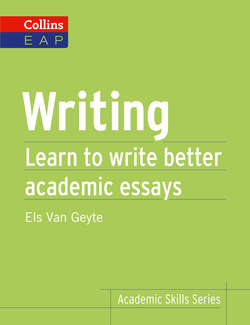Читать книгу Writing: B2+ - Els Geyte Van - Страница 24
The beginning of the essay
ОглавлениеThe essay has to introduce the topic, so must start with a relatively general comment. The trick is not to over-generalize, otherwise the comment becomes meaningless. For example, the following first sentences of an essay are too vague or general.
| First sentence of essay | Comments | Possible improvement |
| 1 Most people hold firmly to the belief that the English language is one of the most popular languages in the world. | English being ‘one of the most popular languages in the world’ is a fact, not a belief. The student wanted to use ‘hold firmly to the belief’, but this language is not right for the content. The statement also seems to be too general: it is not clear what this essay will be about. | The English language is spoken as a first or second language by millions of people, and is becoming even more popular because of its use in electronic communication. |
| 2 Nowadays, many people spend their time watching TV or surfing the internet. | As in the previous example, this sentence says something that most people know, but it does not clearly introduce the topic of the essay. The word ‘nowadays’ is over-used at the beginning of essays. | In the past few decades, traditional pastimes such as reading books have become less popular than technology-based activities such as watching TV and surfing the internet. |
| 3 The need to have a higher degree has often been debated recently. | The student says something that perhaps is not really true: has this really often been debated recently? It looks as if she wanted to use the language ‘has often been debated recently’, which could be said about any topic (the need to use cleaner energy, the need for more public transport, etc.). Even if it is true about the debate, the sentence is not saying much. | The recent rises in tuition fees for first and higher degrees have led to sharp drops in student numbers. |
The following examples get it just right: they are not too general, nor too specific.
| 4 Globalization, a 21st century phenomenon, is having a great impact on countries, not just economically, but also culturally, educationally and socially. |
| 5 Compared to the past we are living in an educated era, with more people attending universities and increasing numbers going abroad to study. |
You will have noted from the comments about examples 1–3 that it is not a good idea to memorize words or phrases (‘nowadays’, ‘has been debated’) to insert your ideas into. It is better to start from your ideas and then to think about how they are best expressed. To do this, you need to think about the time frame, the situation and the certainty.
Although you are generalizing, don’t be vague about the situation and when it happened.
If we analyse what the verbs describe in examples 1–5 above (looking at the improved versions in the column on the right for 1–3), we will find the present continuous tense (is becoming, is having, are living) in examples 1, 4 and 5, which describe ongoing processes. In examples 2 and 3 the present perfect is used, to link a past situation with the present (have become, have led). There is also an example of the present passive form (is spoken) in example 1. Notice that generalizations are unlikely to be expressed in the past tense, unless they are about historical situations.
For more information on tenses, see Chapter 5.
Notice that generalizations often use plural nouns (people, tuition fees, student numbers), and uncountable nouns, i.e. a noun that has no plural form (globalization). It would be strange to use a singular countable noun (person, student), unless it represents a larger category as in the example ‘A student needs to be able to raise thousands of pounds a year’, where the word ‘student’ does not relate to a particular student, but to ‘any student’. The sentence has the same meaning as ‘Students need to be able …’
In the original sentence in example 2, the writer states a truth, without saying what the relevance of it is for the essay. The addition of ‘technology-based activities’ in the improved version tells the reader why surfing the internet and watching TV are mentioned, especially as there is also a contrast with ‘traditional pastimes’. This adds an element of precision, even though the sentence remains general.
Precision is also present in example 4: we know which aspects of globalization the writer is going to discuss. By mentioning the four categories, the writer also indicates the structure of the essay.
You need to indicate very clearly what is fact and what is not.
The claim in (improved) example 1 is that the English language is popular, and the evidence for this is that it is spoken as a first or second language by millions of people and that it is used in electronic communication (which makes it become even more popular).
The writer of example 1 presents a fact and evidence. In example 3, we can read about a cause and its effect. These claims are strong, as evidence is provided.
When less evidence is available, it is better to be cautious and use language that expresses your degree of certainty. This can be done through adverbs (usually, often, undoubtedly, probably, unlikely), adjectives (most, some, certain) and modal verbs (can, may, might).
For more information on cautious language, see Chapters 8 and 9.
Glossary
cautious ADJ If you describe someone’s attitude, language, or reaction as cautious, you mean that it is limited or careful.
